Adobe Experience Platform 101 (The Basics)

25.08.2021: Adobe's AEP Consulting was very kind and reviewed my blog post. So I have made a few adjustments. To visualise the changes, I have underlined them.
AEP has been on the market for some time now and customers keep asking us what it is all about. This article is not intended to help you understand AEP in detail, but it should give you a good overview of the basic AEP construct.
What does the AEP look like?
First of all, "Where do I push the buttons?!"
All AEP products are integrated into the same interface, which looks something like this:
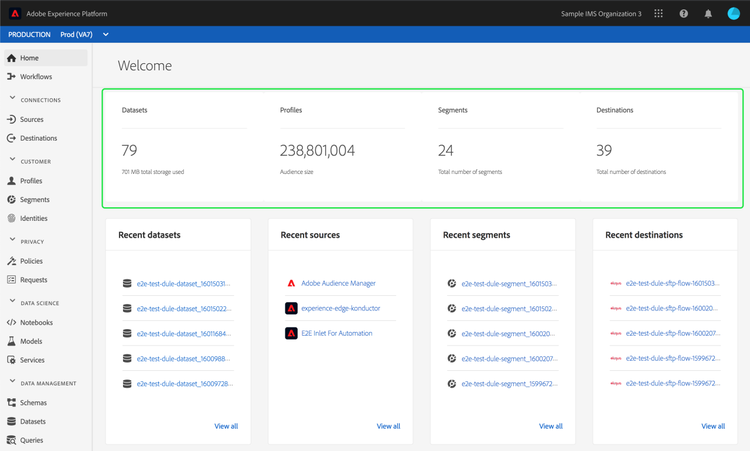
Or like this:
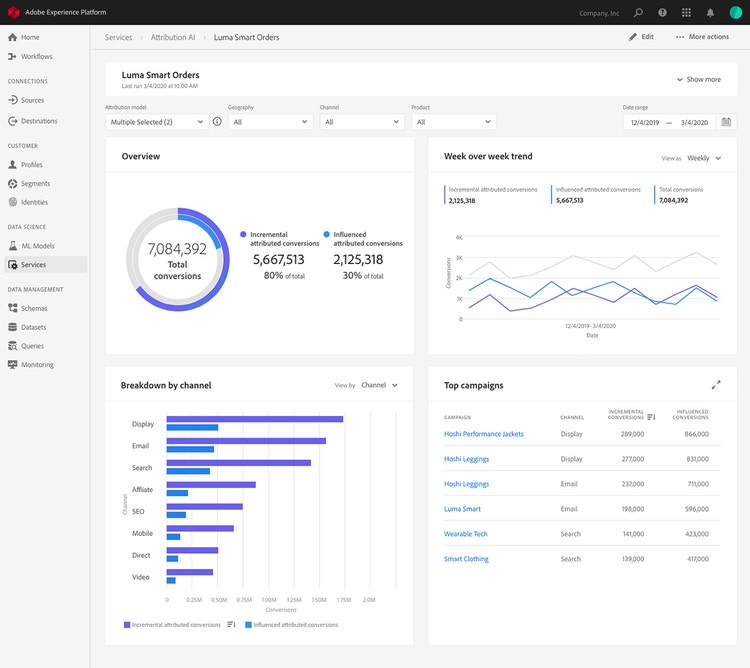
It depends on which products you have licensed. Below you find all current AEP products.
For example, if you have purchased the Intelligent Service product, the Data Science menu item will appear.
AEP and its Products (Adobe SKUs)
Update: In my first blogpost version, I said that you cannot license AEP directly. That is not 100% correct.
There is the Real-Time CDP licence and the Adobe Experience Platform Activation licence that can be used as a "basis". The Adobe Experience Platform Activation includes all the functions of the RTCDP and, in addition, enterprise-level Sources & Destinations, etc.
Therefore, it can be said that the AEP can be licensed as such.
AEP itself can be seen as a very powerful database on which Adobe builds a variety of services that consume, edit, or add AEP data.
Update: The word "database" might suggest a legacy approach. I used the term to massively simplify the construct. Of course, it is not a normal database. Rather: AEP is an open and extensible platform that stitches data across the enterprise, powering real-time customer profiles enhanced through continuous intelligence and governance, and activates content to deliver real-time personalized experiences
The following infographic should give you some insight:
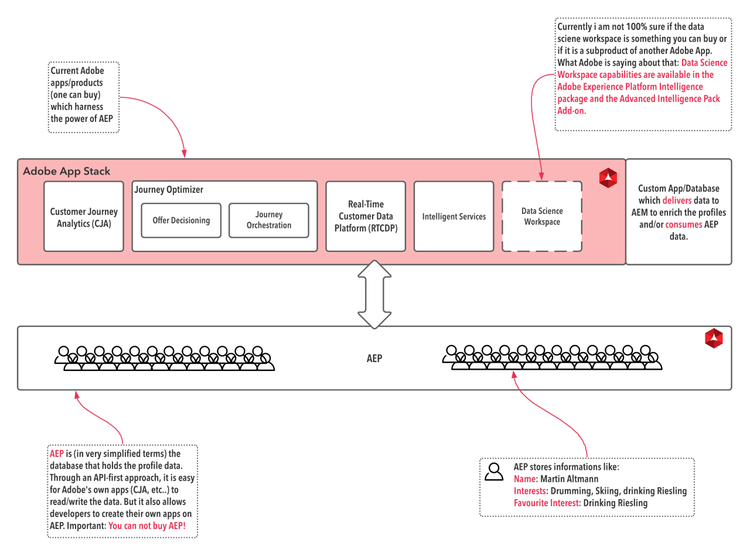
Apps that harness the power of AEP
I would like to give you a brief overview of what each application can do:
Customer Journey Analytics (CJA)
Customer Journey Analytics (CJA) is an Analytics Workspace.
It's as simple as that. It looks like Adobe Analytics, it acts like it, but the data comes from AEP and is not processed in Adobe Analytics.
Since it uses AEP data, which consists of tons of profiles, it is used to visualize that data.
Compare that to Adobe Analytics:
- Unlimited variables and events: The concepts of eVars, props, and events no longer exist. Data is primarily focused on dimensions and metrics. Data sets can have an unlimited amount of unique dimensions and metrics.
- Unlimited unique values: Adobe Experience Platform is not constrained to any unique limitations.
- Alter historical data: Using Adobe Experience Platform, data can be removed or corrected.
- Cross-report-suite data: Existing implementations from multiple data sets can be combined in the Platform.
Customer Journey Analytics lets you control how you connect your online and offline data in Analysis Workspace on any common customer ID, finally allowing you to do attribution, filters, flow, fallout, etc. across your entire customer data set in Customer Journey Analytics.
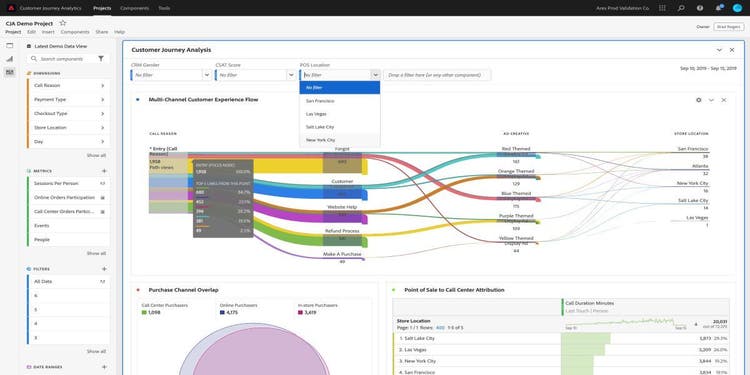
Journey Optimizer
Journey Optimizer is a product that consists of two sub-products. Journey Orchestration and Offer Decisioning.
Journey Orchestration
Journey Orchestration is a service built on AEP that allows you to build real-time orchestration use cases leveraging contextual data stored in events or data sources.
Basically, it is a WYSIWYG workflow builder. In the workflow, you set actions to engage with users who have abandoned their shopping carts. It accesses AEP Data in real-time and performs actions. If someone abandons their cart, you can send them an SMS later in the day to ask them to checkout.
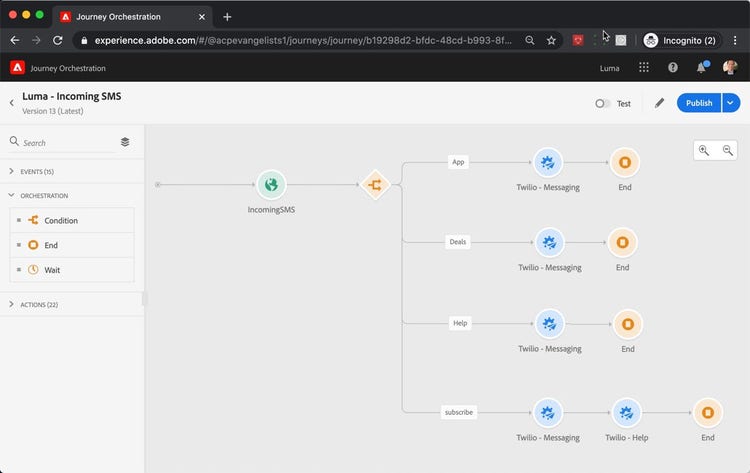
Broaden your Journey Orchestration knowledge here.
Offer Decisioning
The Offer Decisioning application service consists of two main components:
- The Centralized Offer Library is the interface through which you create and manage the various elements that make up your offers, and define their rules and constraints.
- The Offer Decision Engine uses Adobe Experience Platform data and real-time customer profiles along with the Offer Library to select the right time, the right customers, and the right channels to deliver offers.
Basically speaking:
- You create an offer catalogue with all possible offers. These are HTML snippets / images that contain the actual offer. "This and that 20% discount"
- In the next step, you decide where you want to display the offer.
- In the last step, you select the segments that will see the offer.
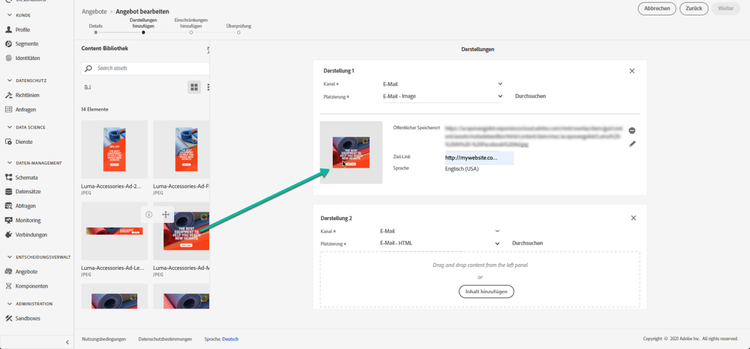
Read more about Offer Decisioning
Real-Time Customer Data Platform (RTCDP)
I have taken the following text from Adobes website since I can't explain it any better:
Built on the Adobe Experience Platform, Real-time Customer Data Platform (Real-time CDP) helps companies bring together known and anonymous data from multiple enterprise sources to create customer profiles that can be used to provide personalized customer experiences across all channels and devices in real-time.
With Real-time Customer Data Platform, you can:
- Achieve a single view of your customer by combining data from across the enterprise.
- Responsibly manage profiles with trusted governance and privacy controls for known and anonymous identifiers.
- Generate actionable insights and scale audiences with AI and machine learning powered by Adobe Sensei and built for marketers.
- Deliver personalized experiences in real time across all channels and destinations.
So RTCDP is one of the core apps you need to start collecting data within AEP.
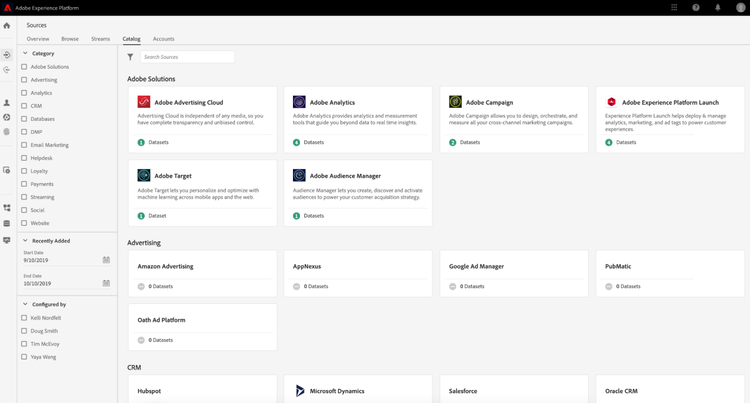
Intelligent Services
The tool, which is based on three different AI services, gives you insights into your customers. It performs statistical analysis of historical AEP data to predict customer behavior.
The three services are Attribution AI, Content and Commerce AI and Customer AI.
Attribution AI: "Attribution AI is used to attribute credits to touchpoints leading to conversion events. This can be used by marketers to help quantify the marketing impact of each individual marketing touchpoint across customer journeys. Examples of touchpoints include display ad impressions, email sends, email opens and paid search clicks."
So imagine a customer journey with different touchpoints. With attribution AI, you know how much marketing and advertising budget was spent on each of the touchpoints.
Content and Commerce AI: It's still in beta, but the current version can generate keywords and tags from documents and automatically label them based on a custom business taxonomy. For images, I can find similar products based on extracted information such as shape and color.
In the future, they want to match this extracted information with the customer profile (because I engaged with that text and this image my profile is enriched with this extracted information) and leverage the enriched profile to deliver personalized customer experiences.
Customer AI: It analyzes historical transaction data to predict, for example, the likelihood of whether an upsell to the next level will be successful or not. Another option would be to predict the churn rate (number of people who cancel a subscription, for example) for a customer segment. With this information, you can either think about why a particular segment has a high churn rate (and do something about it!) or focus on segments with a lower predicted churn rate.
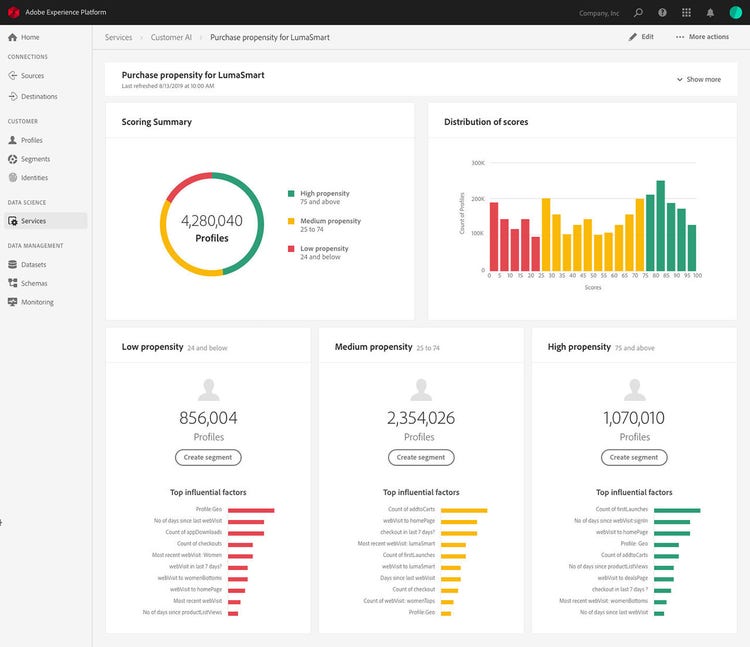
Get more insights about Intelligent Services
Data Science Workspace
First of all, I'm not 100% sure at this point if Data Science Workspace is something you can buy or if it's a sub-product of another Adobe app. What Adobe says: Data Science Workspace capabilities are available in the Adobe Experience Platform Intelligence package and the Advanced Intelligence Pack Add-on.
Update. Data Science Workspace & Query Service are part of the Adobe Experience Platform Intelligence licence
Data Science Workspace is an AI/ML service that uses AEP data to create your own AI/ML recipes if you're not satisfied with what Adobe has built into current AEP solutions.
There are pre-built recipes that you can either use OOTB or manipulate.
After you have trained your model extensively, you have the option to operationalize the model as an intelligent service so that it can be easily activated to both Adobe and non-Adobe products.
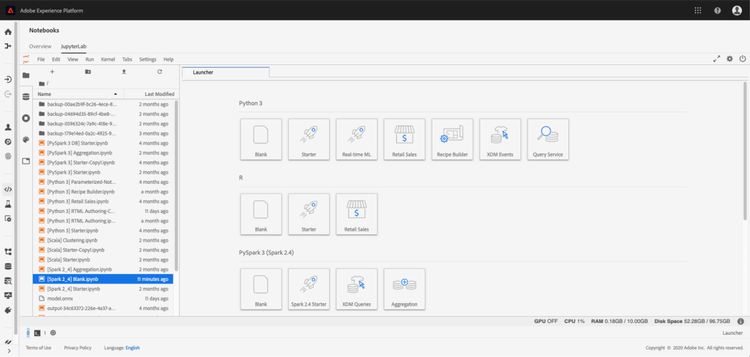
Get nerdy and read more about the data science workspace
Photo by Halacious on Unsplash
AEP Screenshots copyright Adobe on Adobe.com